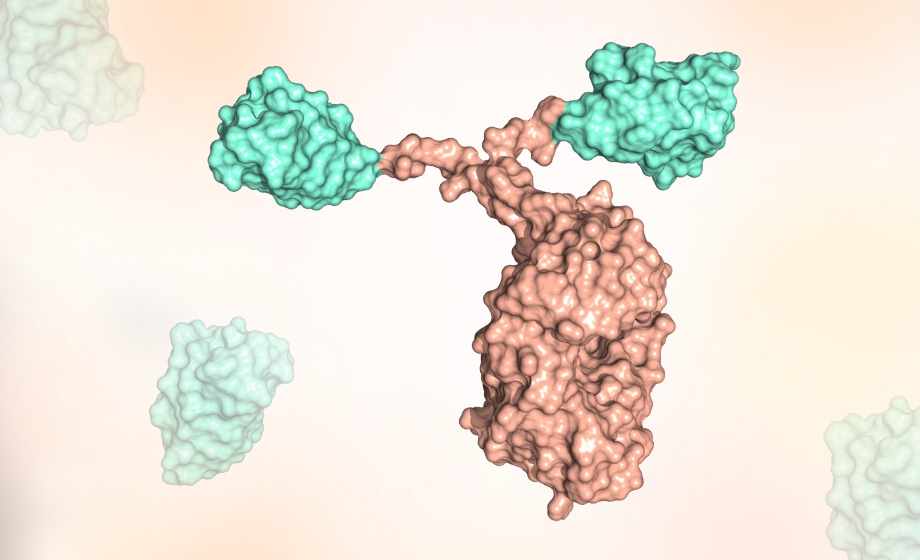Q&A Report: Single-Domain Antibodies: A Promising New Tool for Diagnostic and Therapeutic Research

What animals produce nanobodies?
Nanobodies are recombinantly expressed antigen-binding fragments that are derived from the variable heavy domain (VHH) isolated from the heavy chain of antibodies. These heavy chain antibodies are found in camelids (VHH genes), sharks (variable new antigen receptor, VNAR genes) and shark-like fish only.
What is the actual size of a nanobody?
Nanobodies are 15 kDa in molecular weight with dimensions of approximately 2.5 nm in diameter and 4 nm in height. Nanobodies are 10 times smaller than conventional antibodies, which are 150 kDa in molecular weight.
What is the binding affinity of a nanobody?
Nanobodies have a high specificity and high affinity in the nanomolar or even picomolar range. Binding affinity is highly dependent on antigen target and how the immunized nanobody library was generated.
What is the difference between a Fab and a nanobody?
The fragment antigen-binding region (Fab) is a region on an antibody that binds to antigen and is 50 kDa in size. It is composed of one constant and one variable domain each of heavy chain and light chain. A nanobody is a recombinantly expressed antigen binding fragment derived from the variable heavy chain domain (VHH) of the camelid heavy chain IgG antibody and is 15 kDa in size.
What makes nanobodies preferable over single-chain variable fragments (scFvs) in diagnostics apart from their small size?
ScFvs are engineered by connecting two variable [variable heavy (VH) and variable light (VL)] domains by a flexible linker with a size of 25–30 kDa, which is larger than the nanobody size of 15 kDa. There are significant structural differences and distinct properties between scFvs and nanobodies in vitro and in vivo. Nanobodies have a longer half-life, higher water solubility, superior stability (at high temperature and non-physiological pH), higher tissue penetration, higher affinity binding for cryptic and cavity epitopes, and a lower production cost. In spite of the superior properties of nanobodies, scFvs are still dominant in clinical therapeutic areas and nanobodies are gaining momentum in the recombinant antibody market.
Information derived from A comprehensive comparison between camelid nanobodies and single chain variable fragments (biomedcentral.com)
Can nanobodies cross the blood brain barrier (BBB)?
The blood-brain-barrier (BBB) is a diffusion barrier that stops the influx of compounds from blood to brain. Whether nanobodies can cross the BBB is an active research area to support developing potent therapeutics against brain cancer and neurodegenerative diseases.
What are the standard linkers for bispecific nanobodies for nanobody engineering?
Researchers have successfully generated bispecific nanobodies with a flexible Gly4Ser-linker of 10 or even 5 amino acids to determine target binding and affinity of bispecific T cell engagers (BiTEs) nanobody molecules. This small linker is least prone to proteolysis in vivo and therefore was preferred in the specific study.
Information derived from:
Nanobody Engineering: Toward Next Generation Immunotherapies and Immunoimaging of Cancer (nih.gov)
How much does the immunized custom nanobody service cost?
At Fortis|Abcore, we work with our clients for project customization and provide various deliverable options based on each client’s specific needs. Please contact us to discuss details of your project or visit our Custom Nanobody Discovery Services website for more information.
How long will it take to get my unique nanobody sequence?
If you choose nanobody sequence as your final deliverable, it will take 5–6 months, or roughly 24 weeks including the immunization process. Please contact us to learn about our custom nanobody discovery project or visit our Custom Nanobody Discovery Services website for more information.
What kind of immunogens can you work with?
We have successfully immunized animals with proteins, peptides, DNA, cell lines, small molecules and virus-like particles to generate unique nanobody sequences for different targets. Please contact us if you have other immunogen questions, or visit our Custom Nanobody Discovery Services website for more information.
Contact Details
Have an additional question for Fortis Life Sciences about their nanobody discovery services? Please visit: Fortis Life Sciences | Custom Nanobody Discovery Services.